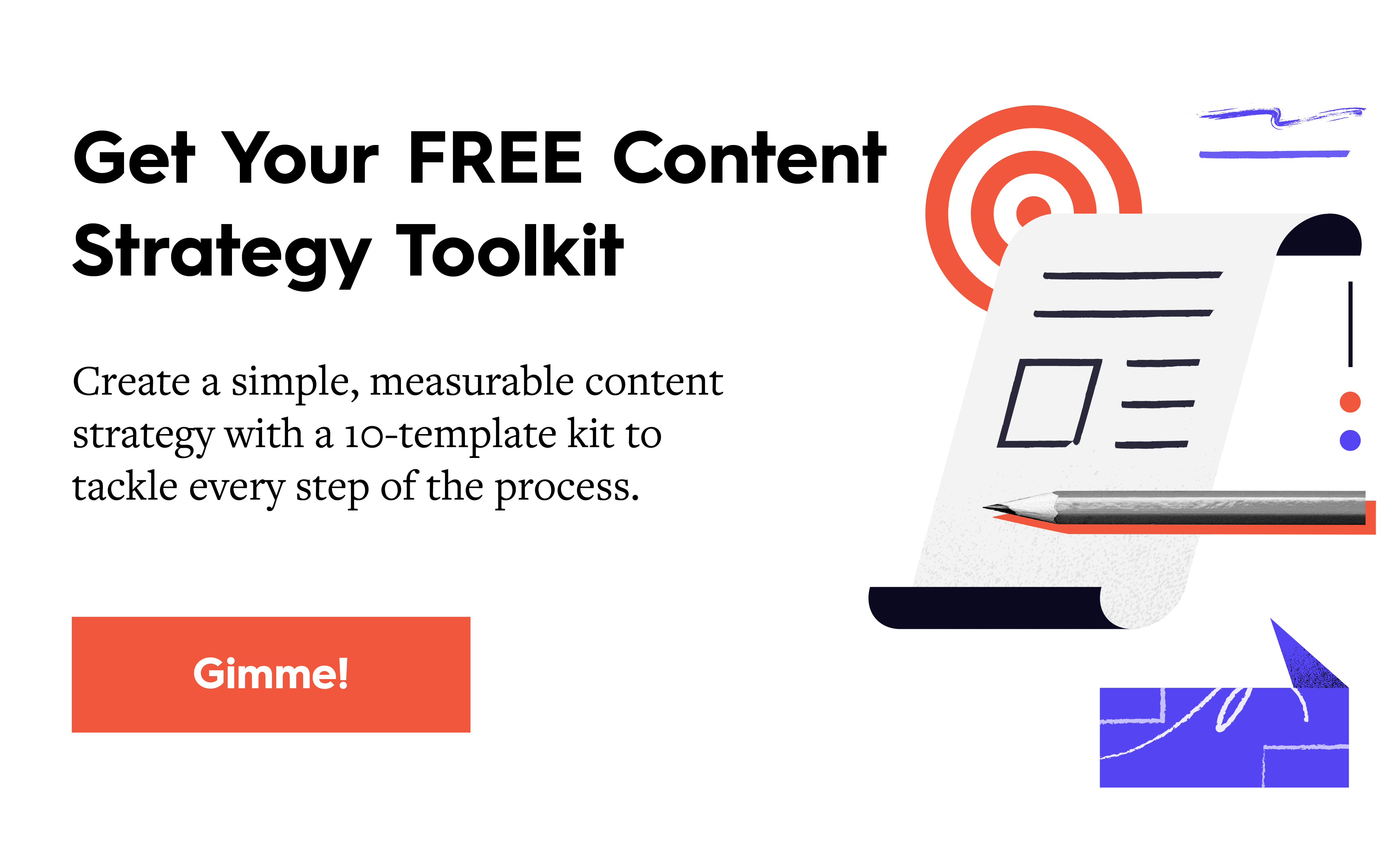Building a strong content strategy isn’t difficult. You just need the knowhow to do it. Since we’ve helped plenty of brands create and/or improve their content strategy, we’ve covered the content strategy process, the common mistakes to avoid, and the questions you need to ask. But over the years we’ve also found a number of helpful content strategy tools and resources that make life easier at every stage of the process.
Today, we thought we’d share some of our favorite ones. Whether you need help coming up with good ideas or help planning your media budget, the handy tools in this roundup will help you craft—and execute—your content strategy efficiently and effectively.

75+ Content Strategy Tools and Resources
Here, we’ve broken these tools and resources down by stage. We hope you find them helpful, and we hope you’ll let us know if there are any great ones you think we missed.
1) Goals and Definitions
To start, you need to identify exactly you’re trying to achieve. (You’ll want to review your analytics and distribution platforms to inform this discussion, too.)
- Hubspot’s guide helps you calculate your lead generation goals.
- Try this beginner’s guide to OKRs, too.
2) Measurement Methodology
Before you create content, you need to know which KPIs, projections, and metrics you’ll be working with.
- This guide helps you figure out which metrics to track.
- Google’s Campaign URL Builder helps you track where your visitors are coming from. (BTW, read more about why you should break your content into campaigns.)
- Kissmetrics helps you increase engagement on site.
3) Journey or Lead Mapping
To understand how to move people through your buyer’s journey, you need to clearly identify the path.
- You can do this with a whiteboard, but UXPressia and Smaply also help you create professional customer journey maps.
3) Audience Insights
You need to know who you’re trying to reach if you want to engage with them successfully.
- If you haven’t made them before, this guide helps you create segmented personas.
- Clarabridge helps you understand customer sentiment and extract helpful insights.
- Netbase and Sprout Social help you monitor social sentiment.
- Foresee and Medallia also help you measure the customer experience at every step of the buyer’s journey.
- SurveyAnyplace helps you create interactive quizzes and surveys to engage with customers.
4) Messaging Platform
To communicate effectively, you need to make sure you’re presenting a cohesive identity.
- Use this framework to identify your brand messaging.
- Try these 5 tips to find your brand voice.
- Craft a cohesive brand identity with our visual identity checklist.
- Use Content Insight or Dyno Mapper to audit your content and gauge whether or not your content is accurately reflecting your brand.
5) Channel Opportunities
Make sure you’re targeting the best channels for your content to connect with the right people.
- Earned Media:
- HypeAuditor helps you identify top-ranking influencers in your industry.
- Grin helps you organize/manage influencers.
- Owned Media:
- This guide helps you optimize your blog for content distribution.
- Hootsuite and Buffer are great to share your content on social.
- Mailchimp helps you distribute content and grow your email marketing list.
- Paid Media:
- Outbrain and Tout help you recommend your own content on top sites.
- Influence.co helps you find influencers for marketing campaigns.
- LinkPizza connects advertisers and influencers.
- Nativo and Sharethrough help automate and scale publishing.
(For more ways to get your content in front of the most people, find out how to craft an effective content distribution strategy in 6 steps.)
6) Storytelling Opportunities
Coming up with strong ideas can be a challenge. Make sure you’re covering topics and issues that resonate with people.
- The ICE scoring system (Impact, Confidence, Ease) can help you vet ideas.
- Survey Monkey and Typeform help you conduct surveys to find out what customers are thinking about (and brainstorm accordingly).
- AnswerThePublic helps you find out what questions people are asking on the Internet.
- Think With Google and Usepanda.com help you find trending topics and articles.
- Buzzsumo tells you what content performs best for any topic or competitor.
7) Editorial Calendar
To maintain your publishing cadence, you need a good editorial calendar. You can always craft one in Google Sheets or Excel, or explore a more official tool.
- Coschedule helps you plan and publish content.
- StoryChief lets you easily create content, collaborate, and publish content.
8) Keyword Strategy
When search traffic is a major goal, your content is only as good as your keywords.
- Moz’s Keyword Planner and Ubersuggest are super easy to use for keyword research. (Also check out Moz’s Beginner’s Guide to SEO.)
- Google Analytics and Moz Analytics help you keep tabs on your traffic.
9) Media Planning
Get the placement you need by planning ahead of time.
- Meltwater helps you track social monitoring and media lists.
- HARO helps you track and contribute to what journalists are looking for.
10) Tech Stack
Make sure you have the infrastructure and software in place to support your strategy. AI tools can be tremendously helpful to increase your productivity and help you do more with less.
- Acrolinx is an enterprise editorial management system that scales compliant content while managing the risks of generative AI.
- Brand24 is an intelligent listening tool.
- Browse AI is an easy way to extract and monitor data from any website.
- Chat.GPT is a free-to-use AI system for content creation and research.
- Content at Scale rafts content in your voice
- Dall-E2 is an AI system that can create realistic images and art from a description in natural language..
- Growthbar lets you make SEO content that Google loves.
- HeadlinesAI helps you generate headlines that convert.
- Hemingway app is a writing and editing app that functions as an assistant writer.
- Influencity is an influencer marketing platform that empowers collaboration.
- Optimizely helps you A/B test to maximize your results.
- Originality AI helps marketers publish with integrity in the world of generative AI.
- Personalize helps you reach the next level of personalization with product, content, and search recommendations.
- Phrasee helps you get more clicks, conversions, and customers with AI content.
- PictoryAI helps you generate more leads and boost sales by turning any content into highly shareable videos.
- Reply.io is an AI-powered sales engagement platform to create new opportunities at scale.
- Seventh Sense is AI software designed to drive maximum performance and engagement with your existing email marketing program.
- Surfer helps you generate SEO content to boost your organic traffic, increase your visibility, and improve your rank.
- Undetectable AI is an AI detector tool to check if your text will be detected as AI-written content.
- Writer.com helps you unlock the power of generative AI across every team.
- Zapier helps you connect tools and automate tasks.
Note: No matter what tech you use, make sure you are complying with legal standards and best practices.
How to Strengthen Your Content Strategy
Remember: There are a lot of factors that can help or prevent your content strategy from being successful.
- Complete every stage of your strategy. Use our step-by-step guide to build a thorough content strategy.
- Make sure every role is covered. The good news is you don’t have to hire a ton of people if you have the right roles covered.
- Get buy-in from your higher-ups. Without it, content can easily get bottlenecked or backburnered.
- Give your team the tools they need. Here are 100+ more content marketing tools and resources to get started.
Most importantly, bring in expert help if you need more support. Find out what to look for in a content agency, find out what it’s like to work with us, or holler at us.





